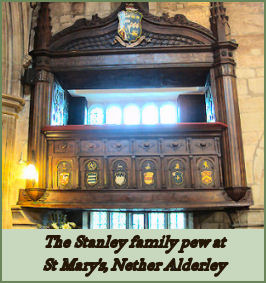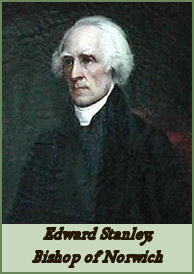The Stanley Family of Alderley
 The first recorded ancestor of the Stanley family was the Norman Adam de Audithlegh, who fought at the Battle of Hastings with William the Conqueror, for which he was rewarded with large estates. The surname derived from his family's estates at Audithlegh in Normandy.
The first recorded ancestor of the Stanley family was the Norman Adam de Audithlegh, who fought at the Battle of Hastings with William the Conqueror, for which he was rewarded with large estates. The surname derived from his family's estates at Audithlegh in Normandy.
Adam had 2 sons, Lyulph and Adam de Audithlegh, Adam, the younger son, married an Anglo-Saxon heiress whose lands included Stoneley, near Leek in Staffordshire, from which the name Stanley derived. His 3 greats-grandson, Sir William de Stanley further increased the family's fortunes by marrying Joan, the daughter and heiress of Sir Philip Bamville, Master Forester of the Wirral, and lord of Storeton near Birkenhead, at Astbury Church in 1282. Through the marriage the Stanley family acquired one-third of the manor of Storeton, he later gained the remaining two-thirds and the hereditary chief rangership of the Forest of Wirral, which then extended over the entire peninsula.
Sir William Stanley, great grandson of the former William, married Alice, daughter of Sir Hamo de Massey of Timperley. Their son, Sir John de Stanley, was appointed as deputy to Robert de Vere, Duke of Ireland in 1386. Stanley led an expedituion to Ireland on behalf of de Vere and King Richard II to quell an insurection. Due to the success of the expedition, Stanley was appointed to the position of Lieutenant of Ireland. In 1389, Richard II appointed him justiciar of Ireland, a post he held until 1391. He was heavily involved in Richard's first expedition to Ireland in 1394–1395. Sir John married Isabel, daughter and heiress of Sir Thomas de Lathom, lord of Lathom and Knowsley in Lancashire. In 1405 he was granted the tenure of the Isle of Man by King Henry IV which had been confiscated from the rebellious Henry Percy, 1st Earl of Northumberland. He and his descendants ruled as Kings of Man until 1736.
His son Sir John Stanley, twice visited the Isle of Mann to put down rebellions (1417 and 1422) and was also responsible for putting the laws of the Island into writing. He purchased the Advowson of Rectory of Winwick, Cheshire from the Nostell Priory, Wakefield in 1433 and from this time onwards, this church, adjacent to his property, was to have close links with the Stanley family. Thomas Stanley, 1st Baron Stanley, the son of Sir John Stanley and Elizabeth Harrington, served as Lord Lieutenant of Ireland from 1431 to 1436 and was appointed comptroller of the royal household by Henry VI in 1432. He married Joan Goushill, the daughter and coheiress of Sir Robert Goushill and Elizabeth FitzAlan, daughter of Richard Fitzalan, 11th Earl of Arundel.
 Thomas Stanley, son of Sir John and Joan, born circa 1435, inherited his father's titles, including that of King of Mann and Baron Stanley. Stanley owned what is now Tatton Park in Cheshire. He married, firstly Eleanor, sister of Richard Neville, Earl of Warwick and secondly to Lady Margaret Beaufort, the mother of Henry VII, as his second wife.
Thomas Stanley, son of Sir John and Joan, born circa 1435, inherited his father's titles, including that of King of Mann and Baron Stanley. Stanley owned what is now Tatton Park in Cheshire. He married, firstly Eleanor, sister of Richard Neville, Earl of Warwick and secondly to Lady Margaret Beaufort, the mother of Henry VII, as his second wife.
He was created Earl of Derby after playing a decisive part in the Battle of Bosworth field, which placed his step-son and the Tudor dynasty on the throne of England and is reputed to have retrieved the crown of England from the battlefield and placed it on the head of his own stepson. His brother William Stanley was later convicted of treason and executed by Henry VII for his support of the pretender Perkin Warbeck. Thomas and William's elder brother, Sir John Stanley, became the founder of the Alderley line of Stanley family. He married Elizabeth, daughter and heiress of Thomas de Weever of Weever and Alderley.
The family resided at Weever for several generations, but Sir John's great-grandson Thomas Stanley, High Sheriff of Cheshire in 1572, made Alderley the main family seat. He re-built the old halls both of Weever and Alderley. The hall was situated in the village of Nether Alderley close to the mill. It was surrounded by a moat, which was crossed by a stone bridge. He was the first member of the family to be buried at Alderley. An alabaster monument in Nether Alderley Church, depicts him in armour, with his four children at his feet.
The monument was lost for centuries but rediscovered during restoration work in 1878. Thomas married Ursula the daughter of Richard Chollmondoly, the marriage produced 2 sons, Thomas and Randle. Randle died on the Isle of Mann in 1595, his son and heir was Sir Thomas Stanley, who in 1596 married Elizabeth, daughter and heiress of Sir Peter Warburton of Grafton, Chief Justice of the Common Pleas. Through this marriage he gained the manors of Anderton and Grafton in Cheshire, and those of Barlow, Dronsfield, and Brighton in Derbyshire. After selling some of his aquisitions in Derbyshire he purchased the manor of Nether Alderley from Sir Edward Fitton of Gawsworth. He was knighted by the first Stuart King, James I, on his progress south to claim the throne after the death of Elizabeth I.
 Thomas son, another Thomas Stanley, inherited the family estates in 1606, when he was aged just 8 and was later made High Sheriff of Cheshire. On the outbreak of the Civil War , he supported the Parliamentarians, but near the end of Oliver Crromwell's protectorate, offered his support to the exiled Charles II, for which he was created a baronet after the Restoration of the Monarchy. Sir Thomas purchased Chorley Hall, in Wilmslow, before 1640. He also embarked on a series of improvements to Alderley Old Hall, building a stone-arched gateway in front of the hall and ading spacious stables. He also was responsible for planting the beech woods near the mere in the park at Alderley.
Thomas son, another Thomas Stanley, inherited the family estates in 1606, when he was aged just 8 and was later made High Sheriff of Cheshire. On the outbreak of the Civil War , he supported the Parliamentarians, but near the end of Oliver Crromwell's protectorate, offered his support to the exiled Charles II, for which he was created a baronet after the Restoration of the Monarchy. Sir Thomas purchased Chorley Hall, in Wilmslow, before 1640. He also embarked on a series of improvements to Alderley Old Hall, building a stone-arched gateway in front of the hall and ading spacious stables. He also was responsible for planting the beech woods near the mere in the park at Alderley.
Sir Peter Stanley, the second baronet, was appointed High Sheriff of Cheshire in 1678. His wife Elizabeth, was the daughter of Sir John Leigh of Northcourt, in the Isle of Wight, the couple had 9 children. He was suceeded by his eldest son Sir Thomas Stanley, who sold off Weever Hall. Sir Thomas Stanley died in 1721, leaving 2 sons, James and Edward, both of whom inherited the title in turn. Edward's son, John Thomas Stanley, enclosed Alderley Edge in 1799, prior to this it had been an uncultivated and bare heath. It was only after this that the fir trees, which are now such a characteristic feature of the Edge, were planted.
His son, Sir John Stanley, sixth baronet succceeded him. In 1779, the family seat of Alderley Old Hall was destroyed in a disastrous fire. Sir John Stanley was in Chester at the time, and while returning to Nether Alderley by Knutsford, recieved news of the disaster from the toll-bar keeper at Ollerton. The fire was said to to have started in the great chimney in the kitchen, the family records and the library, with its large collection of books and papers, were lost. After the fire the family took up residence at Park House, which had formed part of the estates held in Alderley by the Abbey of Dieulacres near Leek.
 Sir John Stanley's son, Sir John Thomas Stanley, (1766-1850) the seventh Baronet, was created Baron Stanley of Alderley by Queen Victoria on May 9th, 1839. He was the author of a number of books including 'A Voyage to the Orknies' (1789) and 'Leonora' (1796) and published two papers in the transactions of the Royal Society of Edinburgh on 'The Hot Springs of Iceland'.
Sir John Stanley's son, Sir John Thomas Stanley, (1766-1850) the seventh Baronet, was created Baron Stanley of Alderley by Queen Victoria on May 9th, 1839. He was the author of a number of books including 'A Voyage to the Orknies' (1789) and 'Leonora' (1796) and published two papers in the transactions of the Royal Society of Edinburgh on 'The Hot Springs of Iceland'.
Sir John Thomas Stanley married Henrietta Maria, the daughter of Viscount Dillon in 1826 in Florence. She was a champion of the rights of women and founded Girton College, Cambridge. The memorial to the left of the altar at St. Mary's depicts their children. His younger brother Edward Stanley, was a popular rector of St. Mary's church Alderley from 1805 – 1837, was keenly interested in education and who was responsible for extending the school house in the churchyard at Nether Alderley. He was appointed Bishop of Norwich in 1837.
Henry Edward John Stanley, third Lord Stanley of Alderley, was the eldest son of the second baron. Henry became fascinated with the East from an early age and even asked for a Arabic grammar as a birthday present when a boy. He converted to Islam and in 1862 married Fabia, daughter of Santiago Frederica San Roman of Seville, but it was later revealed that the lady was already married. Henry delayed notifying his family for seven years and finally announced his marriage after his father's funeral.
A devout Muslim, he closed all the public houses on the family estate, including the Wizard at Alderley Edge. When he died he was buried in unconsecrated ground in the woods. As he had no issue, and his next brother had died in 1873, the title passed to the third brother, Edward Lyulph Stanley (1839-1925) a barrister, who also inherited the barony of Sheffield, which had become extinct in the male line. He was a Captain in the Cheshire Yeomanry during the Boer War, High Sheriff of Anglesey in 1913 and the MP for Eddisbury from 1906-10. He died aged 85, in 1925 and was succeeded by his son Sir Arthur Lyulph Stanley, fifth Baron Stanley of Alderley. He died in 1931, and was succeeded by his son Edward John, sixth Lord Stanley of Alderley. In 1938 he sold the Alderley Park estate, which had been in the family for over 500 years for half a million pounds to Mr. Crundall of London. He died in 1971 to be succeeded by his son, Lyulph Henry Victor Owen Stanley, 7th Baron Stanley of Alderley. The current holder of the title is Thomas Henry Oliver Stanley, 8th Baron Stanley of Alderley.
Back to Cheshire and Derbyshire history menu
